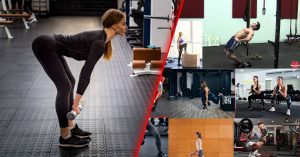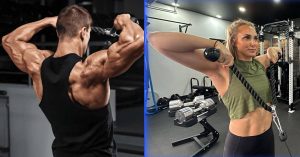Have you ever stopped to think about what makes someone really strong? It’s not just about how much they can bench press or how big their biceps are. Surprisingly, the real secret lies in their back. Yes, that’s right – the back. But to truly unlock its power, you need to focus on specific types of exercises known as compound back exercises.
This area of your body is like a powerhouse, doing so much more than just making you look good. It’s essential for how you move every day, whether you’re lifting groceries, playing sports, or just standing up straight.
So, in this article I will guide you through compound back exercises, its importance, how you can do it and more. Read on as I unravel the details.
Table of contents
MORE keyboard_double_arrow_down LESS keyboard_double_arrow_up
Why Focus on Your Back?
Well, for starters, engaging in compound back exercises is not just for show. It helps to build core strength that supports everything else you do. These exercises enhance your ability to lift heavier across all your workouts, not to mention improving your posture and reducing the risk of injury. But there’s more to it:
- Improves Functional Movement: Your back is involved in almost every move you make. Strengthening it means improving your daily life, from picking up your kids to acing that golf swing.
- Balances Muscle Development: Focusing on your back ensures you’re not just strong in one area. This balance prevents injuries and creates a more symmetrical look.
- Boosts Overall Fitness Performance: A strong back increases your strength in other exercises, like squats and deadlifts. It’s the support system for your entire body.
But how can you start this journey, and what will you discover along the way? Let’s find out.
The Power of Compound Back Exercises
Compound back workouts don’t just target one muscle; they bring several into play with every move. This means more muscles are working, which translates to more strength and muscle growth over time.
But what makes these exercises so special, and how do they transform your back?
- Engage Multiple Muscle Groups: Unlike isolation exercises that target one muscle at a time, compound exercises work out multiple muscles, making your workout more efficient.
- Increase Strength and Size: By engaging more muscles, you’re able to lift heavier weights, which leads to greater strength and muscle size.
- Improve Functional Fitness: These exercises mimic real-life movements, improving your ability to perform everyday tasks with ease.
But wait, there’s a twist. Not all back exercises are created equal. So, what’s the next step? How do you pick the right ones to ensure you’re on the path to a mighty back?
Choosing the Right Compound Back Exercises
Choosing the right exercises is like picking the right tools for a job. You want the ones that will give you the most results. Here are a few to consider:
- Pull-Ups: The classic test of upper body strength, working not just your back but also your arms and shoulders.
- Deadlifts: Targets your lower back, hamstrings, and glutes.
- Rows (Barbell, Dumbbell, or Machine): Perfect for targeting the middle and upper back, improving posture and strength.
But how do you incorporate these into your routine? Find out in the next section.
Building Your Routine
In order to build a good routine. start with basic exercises and gradually increase the difficulty as you become stronger. Here’s a simple plan to get you started:
- Begin with Basics: Start with bodyweight exercises like pull-ups or inverted rows to build foundational strength.
- Add Variety: Incorporate different types of rows and deadlift variations to engage all parts of the back.
- Progressively Overload: Gradually increase the weight or reps to challenge your muscles and ensure continuous growth.
Types of Compound Back Exercises

Now that we’ve discussed the importance of compound back exercises, you may wonder “what are the different types of compound back exercises that are out there that you can try?” Thus, below is a list of compound exercises that you can consider.
The Pull-Up
The journey into compound back exercises begins with the pull-up. The pull-up does more than sculpt your upper body; it challenges and improves your overall strength.
To do this exercise, all you need is a bar. This bodyweight exercise hits your core too, as you fight to stay stable.
Here’s how you can do it:
- Grip the bar overhead, wider than your shoulders.
- Relax, engage your core and upper back, then pull yourself up!
- Aim for your chin to clear the bar, pushing your shoulders away from your ears.
Deadlifts
Deadlifts are a powerful exercise that work your entire back, legs, and hips. They’re great for building overall strength and muscle mass, and you can lift heavy weights with them for serious gains. While your back muscles don’t directly move the weight, they’re crucial for keeping your spine safe during the lift.
Here’s how to do a deadlift:
- Stand with feet shoulder-width apart, hips back, and back straight.
- Bend knees slightly and grip the bar wider than your shoulders.
- Keep your back flat, chest up, and core engaged.
- Push through your legs and pull the bar up to your hips, lifting with your legs and back together.
Remember, proper form is essential for preventing injury. Start with lighter weights and focus on technique before adding more weight. If you’re new to exercise, consider consulting a trainer for personalized guidance.
Bent Over Row
No matter your equipment (kettlebells, barbells, or dumbbells), rowing is a muscle-building champion. You can even hit it on a cable machine! The key is overloading your muscles efficiently by moving serious weight in a bent-over position.Think of it like a deadlift, but lower.
Here’s How you can do best over rows:
- Start with your torso nearly parallel to the floor, wider grip on the bar than usual.
- Lean back, weight on your heels, and row the bar with one hand at a time, starting the pull with your elbow towards your belly. Feel the burn!
Single Arm Row
The single-arm barbell row is basically a one-handed version of the seated cable row. It’s great for building upper back muscles, fixing muscle imbalances, and even strengthening your arms and grip. Here’s how to do it:
- Stand tall next to a bench. Lean one hand and knee on it, and keep your other foot firmly on the ground.
- Grab the barbell with your free hand and keep your back straight and head neutral.
- Pull the barbell up towards your side until your elbow reaches your torso. Feel the squeeze!
- Repeat all your reps on one side, then switch and do the other side.
This exercise is a real winner for a stronger, more balanced back and impressive grip strength.
Inverted Row
Inverted rows are also a great way to build stronger back muscles and better body control. Here is how you can do it:
- Find a sturdy rack and set a bar at a height where your hands barely reach when you lie underneath.
- Grab the bar and hold your body straight like a plank, from head to heels.
- Pull yourself up towards the bar, squeezing your chest in and keeping your elbows close to your sides.
Remember, control is key. Lower yourself back down slowly and repeat!
Insights, Tips, and Advice from Experts
According to experts, here are few things that you should keep in mind when doing compound back exercises:
1. Focus on Form and Technique
Tony Gentilcore, a certified strength and conditioning specialist with extensive experience in coaching and strength training programming states that it’s important to maintain proper form when doing compound back exercises.
Maintaining a neutral spine, engaging the core, and retracting the shoulder blades are key components of proper form during compound back exercises. Failing to do so can lead to injury and reduced effectiveness of the exercise.
2. Maintain Progressive Overload
To continue making progress in back development, experts emphasize the importance of progressive overload. This involves gradually increasing the weight or resistance used during compound back exercises over time to continually challenge the muscles for growth.
3. Allow Sufficient Recovery Time
Giving your back muscles ample time to recover is crucial for growth and injury prevention. Fitness professionals suggest allowing at least 48 hours between intense back workouts to ensure adequate recovery.
4. Warm-Up Properly
Prior to engaging in compound back exercises, it’s essential to perform a thorough warm-up routine. This may include dynamic stretches, mobility drills, and light cardio to prepare the muscles for the upcoming workout.
Additionally, take a look at this Instagram post by Luis Perez, a bodybuilding professional, where he advices on some important points to keep in mind when doing compound back exercises.
Conclusion
Overall, compound back exercises are a great way to build strength, improve posture, reduce injury risk, and boost overall fitness performance. They work multiple muscle groups at the same time, which is more efficient than isolation exercises. So, what are you waiting for? Start incorporating compound back exercises into your routine today!
Key Points
- Strong back muscles improve core strength, posture, daily activities, and balance overall fitness performance.
- Compound exercises engage multiple muscle groups simultaneously, leading to increased strength, size, and functional fitness.
- Pull-ups, deadlifts, rows (barbell, dumbbell, machine) are effective compound back exercises.
- Start with basic bodyweight exercises, add variety, and progressively increase difficulty.
- Pull-ups, deadlifts, bent-over rows, single-arm rows, and inverted rows are specific options.
- Gradually increase weight or resistance over time to challenge muscles for growth.
- Allow at least 48 hours between intense back workouts for proper muscle recovery.
- Remember to consult a trainer if you’re new to exercise or have any concerns about form or technique.
FAQs
What Are Compound Back Exercises?
Compound back exercises are movements that engage multiple muscle groups at once, focusing on the back. These exercises include pull-ups, deadlifts, rows, and more. They are efficient for building strength and muscle mass because they mimic natural movements and allow for the use of heavier weights.
How Often Should I Train My Back?
For most people, training your back 2-3 times per week is sufficient. This allows for adequate recovery while still stimulating muscle growth and strength. The key is to listen to your body and adjust based on your recovery and overall fitness goals.
Can I Perform Compound Back Exercises at Home?
Yes, many compound back exercises can be adapted for home workouts. For example, pull-ups can be done on a sturdy doorframe bar, and rows can be performed with resistance bands or dumbbells. Creativity and proper form can make home workouts effective for back training.
Do I Need Special Equipment for Compound Back Exercises?
While some exercises like deadlifts and lat pulldowns typically require gym equipment, many compound back exercises can be done with minimal equipment. Dumbbells, resistance bands, and bodyweight exercises provide versatile options for effective back training.
How Can I Avoid Injury While Doing Compound Back Exercises?
To avoid injury, focus on proper form and start with weights that allow you to maintain control throughout the movement. Gradually increase the weight as your strength improves. Warm-up properly before your workout and include mobility work to maintain a healthy range of motion.
Can Compound Back Exercises Help with Posture?
Absolutely. Compound back exercises strengthen the muscles that support your spine, including the erector spinae, latissimus dorsi, and traps. Stronger back muscles contribute to better posture, which can reduce back pain and improve overall body alignment.
Are Compound Back Exercises Enough for Total Back Development?
While compound back exercises are foundational for building strength and muscle, incorporating some isolation exercises can help address any imbalances and further refine muscle development. A balanced approach that includes both compound and isolation exercises is ideal for comprehensive back training.
How Long Will It Take to See Results from Compound Back Exercises?
Results depend on your starting point, consistency, diet, and overall lifestyle. Generally, noticeable improvements in strength and muscle size can be observed within 4-6 weeks of consistent, progressive back training. Remember, fitness is a marathon, not a sprint; long-term commitment yields the most significant results.

ABOUT THE AUTHOR
Follow Valen Steven for a dose of fitness enthusiasm, evidence-based advice, and a roadmap to achieving your health and wellness goals.
Subscribe to our Newsletter
Dive into a world of fitness and wellness with our exclusive newsletter! Sign up now and receive weekly power-packs of fitness wisdom




